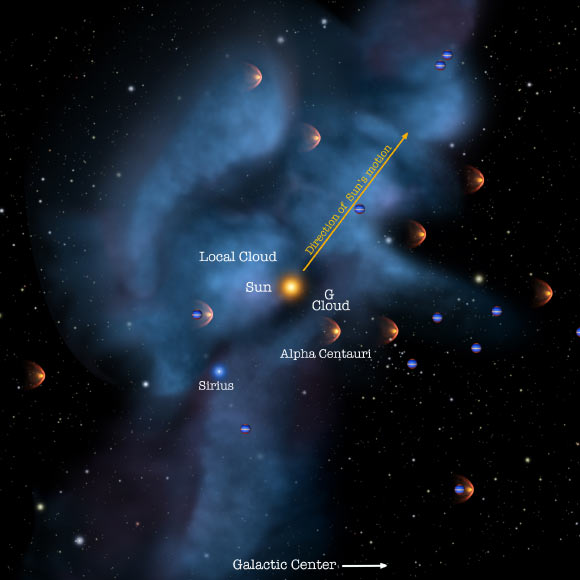An international team of scientists has found interstellar iron-60, a radioactive isotope with a half-life of 2.6 million years that is predominantly produced in massive stars and ejected in supernova explosions, in deep-sea sediments dating from 33,000 years ago to the present.

The Solar System moves through the Local Interstellar Cloud. Image credit: NASA / Adler / University of Chicago / Wesleyan.
Radioactive elements synthesized in massive stars are ejected into space via stellar winds and supernova explosions.
Our Solar System moves through the interstellar medium and collects these extrasolar products.
One such product is iron-60. Because it is not naturally produced on Earth, the presence of this radioactive isotope is a sensitive indicator of supernova explosions within the last few million years.
Australian National University’s Dr. Anton Wallner and colleagues previously found traces of iron-60 at about 2.6 million years ago, and possibly another at around 6 million years ago, suggesting our planet had traveled through fallout clouds from nearby supernovae.
They also found the rare isotope in samples of lunar soil returned to Earth by the Apollo 12, 15 and 16 missions, and in samples of snow from Antarctica.
“For the last few thousand years, the Solar System has been moving through a denser cloud of gas and dust, known as the Local Interstellar Cloud, whose origins are unclear,” they said.
“If this cloud had originated during the past few million years from a supernova, it would contain iron-60, and so we decided to search more recent sediment to find out.”
The researchers searched through several deep-sea sediments from two different locations that date back 33,000 years using an extremely sensitive mass spectrometer.
They found clear traces of iron-60; its distribution matched Earth’s recent travel through the Local Interstellar Cloud.
But the radioactive isotope extended further back and was spread throughout the entire 33,000 year measurement period.
“The lack of correlation with the Solar System’s time in the current Local Interstellar Cloud seems to pose more questions than it answers,” the authors said.
“Firstly, if the cloud was not formed by a supernova, where did it come from? And secondly, why is there iron-60 so evenly spread throughout space?”
“There are recent papers that suggest iron-60 trapped in dust particles might bounce around in the interstellar medium,” Dr. Wallner said.
“So the iron-60 could originate from even older supernovae explosions, and what we measure is some kind of echo. More data is required to resolve these details.”
A paper on the findings was published online in the Proceedings of the National Academy of Sciences.
_____
A. Wallner et al. 60Fe deposition during the late Pleistocene and the Holocene echoes past supernova activity. PNAS, published online August 24, 2020; doi: 10.1073/pnas.1916769117







